In line with the World Health Organisation, New Zealand’s Ministry of Health recommends that children and young people aged 5–17 should be doing at least 60 minutes of moderate to vigorous physical activity every day. But when it comes to our kids, there seem to be two contrasting polarities.
On the one hand, half of our kids aged 5–14 years favour a more sedentary lifestyle, watching 2 or more hours of TV a day. And only 10% of secondary school students are meeting the current recommendations of 60 minutes of physical activity daily, according to the Youth’12 survey.
On the other hand, some of our kids might be doing too much exercise; particularly those who play sports simultaneously in school and national or provincial teams, which can leave them susceptible to injury and burnout.
‘But kids are young – they’ve got bundles of energy!’
They may be young and energetic, but they’re skeletally immature. So, while they’re building strength through sports, their bodies are also trying to produce muscle and bone.
This is an uphill struggle if the body isn’t getting enough water, sleep or healthy food. And can increase the risk of repetitive strain injuries, muscle fatigue or burnout. These issues not only affect children’s physical mobility, they can also take away the psychological benefits – the enjoyment – that kids get from being active.
So how much sport is too much for our kids?
It’s hard to say because every child’s physical strength and fitness levels are different. Plus, injuries like strains and bruises are just part and parcel of contact sports. But they can be very painful and put your child out of action for a fair few weeks.
As osteopaths, we can help relieve your child’s immediate pain and enable their body to function better and recover more quickly. Repetitive strain injuries – like sprained ankles, inflamed tendons, shin splints and general aches and pains – are treated with specialised stretching and strengthening routines to condition the muscles.
And what about burnout?
The tell-tale signs of burnout in young people include disturbed sleep and a reluctance to go to an activity they once loved.
These physical setbacks tend to happen when kids throw themselves into something, or when they play multiple sports in the same week.
The demand of training means they end up doing too much, too fast and too soon. So, to avoid strains and fatigue, make sure they gradually build their level of activity up. And, if they do experience any injury or discomfort, seek advice from your osteopath.
If you have an active kid, remember: recovery is crucial
With TV and video games coaxing kids to lead sedentary lives, it’s never been more important to encourage your kids to lead an active lifestyle. But, if they’re already active, it’s also important to encourage rest days which, contrary to the way they sound, don’t have to be spent sitting on the sofa.
If your child plays a lot of the same sport, rest days give the muscles groups and joints associated with that sport time to recuperate. On these days, try doing a gentle activity – like swimming, an easy bike ride or a walk in the park.
If your kid plays sports at a national level, they can avoid injury by building strength safely
If your child is playing sports at a national or provincial level, strengthening and conditioning – like lifting weights – can prevent sports injuries. But there’s long been discussions on its suitability for young people whose bodies are still developing.
The advice now is for young people to only use their body weight to target main muscle groups through exercises like press-ups, squats, lunges and pull-ups.
A supervised resistance program two to three times a week is more than enough. And young people should avoid adding heavy weights until their bodies have fully developed, which is normally around aged 18.
If you’d like advice on child-specific sports injuries or resistance exercise programs, get in touch and speak to one of our osteopaths.
Back to blog
